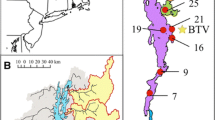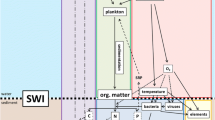Abstract
Measures to reduce lake phosphorus concentrations have been encouragingly successful in many parts of the world. After significant eutrophication in the twentieth century, nutrient concentrations have declined in many natural settings. In addition to these direct anthropogenic impacts, however, climate change is also altering various processes in lakes. Its effects on lacustrine nutrient budgets remain poorly understood. Here we investigate the total phosphorus (TP) concentrations in the epilimnion of the meromictic Lake Zug under present and future climatic conditions. Results are compared with those of other deep lakes. Data showed that TP transported from the hypolimnion by convective winter mixing was the most important source of TP for the epilimnion, reaching values more than ten times higher than the external input from the catchment. We found a logarithmic relationship between winter mixing depth (WMD) and epilimnetic TP content in spring. Warming climate affects WMD mainly due to its dependence on autumn stratification. Model simulations predict a reduction of average WMD from 78 (current) to 65 m in 2085 assuming IPCC scenario A2. Other scenarios show similar but smaller changes in the future. In scenario A2, climate change is predicted to reduce epilimnetic TP concentrations by up to 24% during warm winters and may consequently introduce significant year-to-year variability in primary productivity.




Similar content being viewed by others
References
Anneville O, Ginot V, Angeli N (2002) Restoration of Lake Geneva: expected versus observed responses of phytoplankton to decreases in phosphorus. Lakes Reserv Res Manag 7:67–80. https://doi.org/10.1046/j.1440-169X.2002.00179.x
Anneville O, Gammeter S, Straile D (2005) Phosphorus decrease and climate variability: mediators of synchrony in phytoplankton changes among European peri-alpine lakes. Freshw Biol 50:1731–1746. https://doi.org/10.1111/j.1365-2427.2005.01429.x
AquaPlus (2001) Entwicklung des Gesamtphosphors im Zugersee anhand der im Sediment eingelagerten Kieselalgen. Baudirektion des Kantons Zug, Amt für Umweltschutz, Zug
CH2011 (2011) Swiss Climate Change Scenarios CH2011. C2SM, MeteoSwiss, ETH, NCCR Climate, and OcCC
Coulter GW (1968) Thermal stratification in the deep hypolimnion of Lake Tanganyika. Limnol Oceanogr 13:385–387. https://doi.org/10.4319/lo.1968.13.2.0385
De Pinto JV, Young TC, McIlroy LM (1986) Great lakes water quality improvement. Environ Sci Technol 20:752–759. https://doi.org/10.1021/es00150a001
Degens ET, Von Herzen RP, Wong H-K (1971) Lake Tanganyika: water chemistry, sediments, geological structure. Naturwissenschaften 58:229–241
Dillon PJ, Rigler FH (1974) The phosphorus-chlorophyll relationship in lakes. Limnol Ocean 19:767–773. https://doi.org/10.4319/lo.1974.19.5.0767
Doherty J (2013) PEST: software for model-independent parameter estimation. Watermark Numerical Computing, Brisbane
Ficker H, Luger M, Gassner H (2017) From dimictic to monomictic: empirical evidence of thermal regime transitions in three deep alpine lakes in Austria induced by climate change. Freshw Biol 62:1335–1345. https://doi.org/10.1111/fwb.12946
Finger D, Wüest A, Bossard P (2013) Effects of oligotrophication on primary production in peri-alpine lakes. Water Resour Res 49:4700–4710. https://doi.org/10.1002/wrcr.20355
Fink G, Schmid M, Wahl B, Wolf T, Wüest A (2014) Heat flux modifications related to climate-induced warming of large European lakes. Water Resour Res 50:2072–2085. https://doi.org/10.1002/2013WR014448
Gächter R, Wehrli B (1998) Ten years of artificial mixing and oxygenation: no effect on the internal phosphorus loading of two eutrophic lakes. Environ Sci Technol 32:3659–3665. https://doi.org/10.1021/es980418l
Gaudard A, Schwefel R, Råman Vinnå L, Schmid M, Wüest A, Bouffard D (2017) Optimizing the parameterization of deep mixing and internal seiches in one-dimensional hydrodynamic models: a case study with Simstrat v1.3. Geosci Model Dev 10:3411–3423. https://doi.org/10.5194/gmd-10-3411-2017
Goudsmit GH, Burchard H, Peeters F, Wüest A (2002) Application of k-ϵ turbulence models to enclosed basins: the role of internal seiches. J Geophys Res 107:3230. https://doi.org/10.1029/2001JC000954
Holzner CP, Aeschbach-Hertig W, Simona M, Veronesi M, Imboden D, Kipfer R (2009) Exceptional mixing events in meromictic Lake Lugano (Switzerland/Italy), studied using environmental tracers. Limnol Oceanogr 54:1113–1124. https://doi.org/10.4319/lo.2009.54.4.1113
Imboden DM, Stotz B, Wüest A (1988) Hypolimnic mixing in a deep alpine lake and the role of a storm event. Int Ver Für Theor Angew Limnol Verhandlungen 23:67–73
Jeppesen E, Søndergaard M, Jensen JP, Havens K, Anneville O, Carvalho L, Coveney M, Deneke R, Doukulil M, Foy B (2005) Lake responses to reduced nutrient loading–an analysis of contemporary long-term data from 35 case studies. Freshw Biol 50:1747–1771
Lepori F, Bartosiewicz M, Simona M, Veronesi M (2018) Effects of winter weather and mixing regime on the restoration of a deep perialpine lake (Lake Lugano, Switzerland and Italy). Hydrobiologia 824:229–242. https://doi.org/10.1007/s10750-018-3575-2
MacIntyre S, Flynn KM, Jellison R, Romero JR (1999) Boundary mixing and nutrient fluxes in Mono Lake, California. Limnol Oceanogr 44:512–529
Makarewicz JC (1993) Phytoplankton biomass and species composition in Lake Erie, 1970 to 1987. J Gt Lakes Res 19:258–274
Moosmann L, Gächter R, Müller B, Wüest A (2006) Is phosphorus retention in autochthonous lake sediments controlled by oxygen or phosphorus? Limnol Oceanogr 51:763–771. https://doi.org/10.4319/lo.2006.51.1_part_2.0763
Moss B, Kosten S, Meerhof M, Battarbee R, Jeppesen E, Mazzeo N, Havens K, Lacerot G, Liu Z, De Meester L (2011) Allied attack: climate change and eutrophication. Inland Waters 1:101–105. https://doi.org/10.5268/IW-1.2.359
Müller B, Wüest A (2016) Abnahme des Phosphorgehalts im Zugersee Stand 2016. Eawag, Kastanienbaum
Müller B, Bryant LD, Matzinger A, Wüest A (2012a) Hypolimnetic oxygen depletion in eutrophic lakes. Environ Sci Technol 46:9964–9971. https://doi.org/10.1021/es301422r
Müller B, Och L, Wüest A (2012b) Entwicklung des Phosphorhaushalts und der Sauerstoffzehrung im Sempacher- und Baldeggersee. Eawag, Kastanienbaum
Müller B, Gächter R, Wüest A (2014) Accelerated water quality improvement during oligotrophication in peri-alpine lakes. Environ Sci Technol 48:6671–6677. https://doi.org/10.1021/es4040304
North RP, North RL, Livingstone DM, Köster O, Kipfer R (2014) Long-term changes in hypoxia and soluble reactive phosphorus in the hypolimnion of a large temperate lake: consequences of a climate regime shift. Glob Change Biol 20:811–823. https://doi.org/10.1111/gcb.12371
O’Reilly CM, Alin SR, Plisnier P-D, Cohen A, McKee B (2003) Climate change decreases aquatic ecosystem productivity of Lake Tanganyika, Africa. Nature 424:766–768
O’Reilly CM, Sharma S, Gray DK et al (2015) Rapid and highly variable warming of lake surface waters around the globe. Geophys Res Lett 42:10773–10781. https://doi.org/10.1002/2015GL066235
Peeters F, Livingstone DM, Goudsmit G-H, Kipfer R, Forster R (2002) Modeling 50 years of historical temperature profiles in a large central European lake. Limnol Oceanogr 47:186–197. https://doi.org/10.4319/lo.2002.47.1.0186
Perroud M, Goyette S, Martynov A, Beniston M, Anneville O (2009) Simulation of multiannual thermal profiles in deep Lake Geneva: a comparison of one-dimensional lake models. Limnol Oceanogr Methods 54:1574–1594
Rogora M, Buzzi F, Dresti C, Leoni B, Lepori F, Mosello R, Patelli M, Salamaso N (2018) Climatic effects on vertical mixing and deep-water oxygen content in the subalpine lakes in Italy. Hydrobiologia 824:33–50. https://doi.org/10.1007/s10750-018-3623-y
Rueda FJ, Schladow G, Pálmarsson S (2003) Basin-scale internal wave dynamics during a winter cooling period in a large lake. J Geophys Res Oceans 108(C3):3097. https://doi.org/10.1029/2001JC000942
Sahoo GB, Schladow SG, Reuter JE, Coats R, Dettinger M, Riverson J, Wolfe B, Costa-Cabral M (2013) The response of Lake Tahoe to climate change. Clim Change 116:71–95. https://doi.org/10.1007/s10584-012-0600-8
Salmaso N, Boscaini A, Capelli C, Cerasino L (2018) Ongoing ecological shifts in a large lake are driven by climate change and eutrophication: evidences from a three-decade study in Lake Garda. Hydrobiologia 824:177–195. https://doi.org/10.1007/s10750-017-3402-1
Schindler DW (2006) Recent advances in the understanding and management of eutrophication. Limnol Oceanogr 51:356–363. https://doi.org/10.4319/lo.2006.51.1_part_2.0356
Schmid M, Hunziker S, Wüest A (2014) Lake surface temperatures in a changing climate: a global sensitivity analysis. Clim Change 124:301–315. https://doi.org/10.1007/s10584-014-1087-2
Schwefel R, Gaudard A, Wüest A, Bouffard D (2016) Effects of climate change on deep-water oxygen and winter mixing in a deep lake (Lake Geneva)—comparing observational findings and modeling. Water Resour Res 52:8811–8826. https://doi.org/10.1002/2016WR019194
Schwefel R, Steinsberger T, Bouffard D, Bryant LD, Müller B, Wüest A (2018) Using small-scale measurements to estimate hypolimnetic oxygen depletion in a deep lake. Limnol Oceanogr 63:S54–S67. https://doi.org/10.1002/lno.10723
Simona M (2003) Winter and spring mixing depths affect the trophic status and composition of phytoplankton in the northern meromictic basin of Lake Lugano. J Limnol 62:190–206. https://doi.org/10.4081/jlimnol.2003.190
Straile D, Jöhnk K, Rossknecht H (2003) Complex effects of winter warming on the physicochemical characteristics of a deep lake. Limnol Oceanogr 48:1432–1438. https://doi.org/10.4319/lo.2003.48.4.1432
Vollenweider RA (1968) Scientific fundamentals of the eutrophication of lakes and flowing waters, with particular reference to nitrogen and phosphorus as factors in eutrophication. OECD Paris Tech Rep 5CSI6827
Wüest A, Gloor M (1998) Bottom boundary mixing: the role of near-sediment density stratification. In: Imberger J (ed) Physical processes in lakes and oceans. Coastal and estuarine studies 54. Academic Press, New York, pp 485–502
Wüest A, Lorke A (2003) Small-scale hydrodynamics in lakes. Annu Rev Fluid Mech 35:373–412. https://doi.org/10.1146/annurev.fluid.35.101101.161220
Yankova Y, Neuenschwander S, Köster O, Posch T (2017) Abrupt stop of deep water turnover with lake warming: drastic consequences for algal primary producers. Sci Rep 7:13770
Acknowledgments
We sincerely thank the anonymous reviewers and the editor for their valuable comments. In addition, we are grateful to René Gächter for valuable comments to an earlier version of the manuscript. We also acknowledge the support of the Amt für Umweltschutz Zug, especially Bruno Mathis and Peter Keller, who provided observational data from Lake Zug. Long-term monitoring data for Lake Geneva were provided by the Commission International pour la Protection des Eaux du Léman (CIPEL) and by the SOERE OLA Information System (http://si-ola.inra.fr), INRA Thonon-les-Bains. Data from Lake Zürich were provided by AWEL Zürich. The CH2011 climate predictions were obtained from the Center for Climate Systems Modeling (C2SM; www.ch2011.ch). Meteorological data of this study are archived and distributed by the Swiss Federal Office of Meteorology and Climatology, MeteoSwiss (obtained via their data portal, IDAWEB). Additional information on the data can be provided on request by alfred.wueest@eawag.ch. The source code for SIMSTRAT can be accessed through the archived GIT repository (link: https://github.com/adrien-ga/Simstrat-BSIW/tree/v1.3, https://doi.org/10.5281/zenodo.841084). The first author was supported by Swiss National Science Foundation grants 200021_146652 and 200020_165517.
We dedicate this article to the memory of our wonderful friend and colleague Adrien Gaudard who unexpectedly passed away after a recent avalanche accident.
Author information
Authors and Affiliations
Corresponding author
Additional information
Publisher's Note
Springer Nature remains neutral with regard to jurisdictional claims in published maps and institutional affiliations.
Electronic supplementary material
Below is the link to the electronic supplementary material.
Rights and permissions
About this article
Cite this article
Schwefel, R., Müller, B., Boisgontier, H. et al. Global warming affects nutrient upwelling in deep lakes. Aquat Sci 81, 50 (2019). https://doi.org/10.1007/s00027-019-0637-0
Received:
Accepted:
Published:
DOI: https://doi.org/10.1007/s00027-019-0637-0




